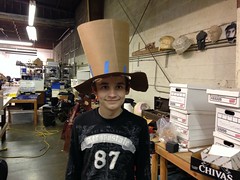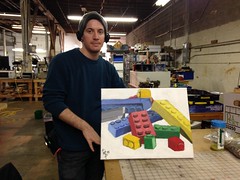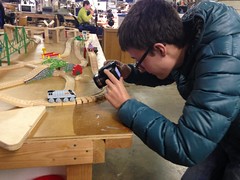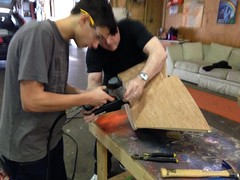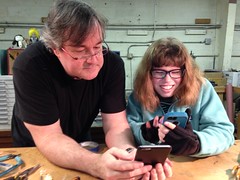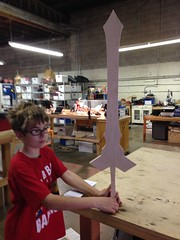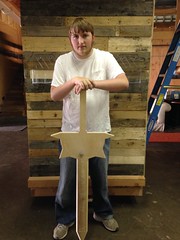Janet Lawson, MFT | September 13, 2016
The Prolonged Developmental Phases of an Autistic Child
*This is a paper I wrote in 2001 when my now adult son was nearing his seventh birthday. It was written for a graduate psychology class, Phases of Human Development. I found it in a box as I was going through old papers and realized that 15 years later I am still watching my son create his identity and I still believe that language is key to his development.*
 At first glance my son, Ian appears to be like any other seven-year-old. He has a lithe and agile body, clear gray eyes, and a wide infectious grin. He walks boldly across a balance beam, swings high on the schoolyard swings and screams with delight as he slides down the slide. But when one stops to study him it is soon apparent that Ian is not a typical seven-year old. He does not join in the games with other children. He does not respond to conversational or social cues the way one would expect. He does not venture out into the playground without a designated adult as an anchor. And, when alarmed, he responds with the intensity and total physical reflex of a trapped feral animal. Ian is autistic.
At first glance my son, Ian appears to be like any other seven-year-old. He has a lithe and agile body, clear gray eyes, and a wide infectious grin. He walks boldly across a balance beam, swings high on the schoolyard swings and screams with delight as he slides down the slide. But when one stops to study him it is soon apparent that Ian is not a typical seven-year old. He does not join in the games with other children. He does not respond to conversational or social cues the way one would expect. He does not venture out into the playground without a designated adult as an anchor. And, when alarmed, he responds with the intensity and total physical reflex of a trapped feral animal. Ian is autistic.
No one knows what makes Ian autistic. It may be a damaged neural pathway in the brain. It could be a chemical imbalance causing receptive and expressive language aphasia. It could be a central nervous system dysfunction. We may never know the exact cause of his condition but it is clear that the effects of this condition, lack of language and social skills have had a profound effect on Ian’s personal development.
Before we discuss what Ian lacks let’s look at who Ian is. Ian entered this world with his arms outstretched and a victorious gleam in his eye. Thomas Verny (1988) contends that a child’s prenatal experience, what he feels and perceives in the womb, “begins shaping his attitudes and expectations about himself” (p. 12) He also argues that the mothers attitude toward her pregnancy influences the in utero experience. If he is correct that may explain why Ian is such a joyous, sensuous, and confident child.
The nine months that I carried Ian were the happiest months of my life. I was 38 years old, healthy and living in a very supportive environment. My husband was in grad school and several of our friends were starting families. It was perhaps the only time that I had no doubt about what I was doing or what my purpose in live was. I worked in a local library and took classes toward my masters’ degree in library and information science. I gained fifty pounds and loved every ounce. My world was shaped and defined by my pregnancy.
I spent hours rubbing my tummy and talking to my son (the amniocentesis had shown that he was a boy). Verny states that at five months the fetus is “as sensitive to touch as any one-year-old”. (p. 37) This may be the reason that Ian is such a sensuous person. Unlike many autistics who find touch to be over stimulating, Ian is calmed by human contact. Rubbing his back will relax him when he is stressed and when he is upset he will ask for a hug. Verny cites studies that indicate that fetuses actually learn in the womb. It may be that by responding to Ian’s prenatal movements with rubbing motions he learned that touch can be a calming agent.
 At the very end of my pregnancy I developed serious high blood pressure and pre-eclampsia. I was hospitalized and all my bodily functions and Ian’s were carefully monitored. The condition worsened and I had an acute seizure during labor. What had been a very peaceful pregnancy became an extremely stressful and dramatic birth. With the onset of the seizure I was rushed into an operating room and Ian was delivered by emergency C-section. In discussing the work of Dr. Sontag, Verny describes the affect of maternal stress on a child as “heightening a child’s biological susceptibility to emotional distress.” (p. 54) This may explain Ian’s extreme physical response when alarmed. The best description of his behavior in these situations is that he ‘goes feral’. His eyes widen, his body tenses and, if cornered, he will lash out. Could this be a learned response from a time when the situation was dire and he was truly trapped?
At the very end of my pregnancy I developed serious high blood pressure and pre-eclampsia. I was hospitalized and all my bodily functions and Ian’s were carefully monitored. The condition worsened and I had an acute seizure during labor. What had been a very peaceful pregnancy became an extremely stressful and dramatic birth. With the onset of the seizure I was rushed into an operating room and Ian was delivered by emergency C-section. In discussing the work of Dr. Sontag, Verny describes the affect of maternal stress on a child as “heightening a child’s biological susceptibility to emotional distress.” (p. 54) This may explain Ian’s extreme physical response when alarmed. The best description of his behavior in these situations is that he ‘goes feral’. His eyes widen, his body tenses and, if cornered, he will lash out. Could this be a learned response from a time when the situation was dire and he was truly trapped?
After that dramatic entry into the world Ian’s first year proceeded fairly normally. His growth and physical progress closely followed the normal developmental charts and he met most of the developmental milestones during that first year. (Mussen 1979) He rolled over at three months, began to crawl at seven months and took his first steps at nine months. Though he made cooing sounds, he was not very vocal. Studies have shown that American infants vocalize 25% of the time (Mussen) whereas Ian made noises no more than 10% of the time.
 His first few weeks of life he was most comfortable when wrapped tightly in a receiving blanket – a swaddling trick that I had been taught at the hospital. When securely wrapped he would be calm. In times of “alert inactivity” (Mahler 1975) Ian was more interested in inanimate objects then he was in people. For Ian, people were like great pillows made for snuggling. He rarely engaged in peek-a-boo games nor did he respond to children’s rhyming games. But when on the floor with his toys and stuffed animals he would coo and study them intently.
His first few weeks of life he was most comfortable when wrapped tightly in a receiving blanket – a swaddling trick that I had been taught at the hospital. When securely wrapped he would be calm. In times of “alert inactivity” (Mahler 1975) Ian was more interested in inanimate objects then he was in people. For Ian, people were like great pillows made for snuggling. He rarely engaged in peek-a-boo games nor did he respond to children’s rhyming games. But when on the floor with his toys and stuffed animals he would coo and study them intently.
The first clear developmental milestone missed was the smile. Typically, an infant will smile at 2-4 months of age. Margaret Mahler (1975) argues that this social smile is in response to the mother’s face and signals the beginning of the symbiotic phase. Though Ian did not smile it was around this time that he began to reach up and gently stroke my cheek while I nursed him. That reaching out could have been an indication that he had begun “to dimly perceive need satisfaction as coming from some need-satisfying part-object” (p.48) and thus had taken the first step along the road to individuation.
 Mahler suggests that the smile response may be influenced by the “holding behavior” of the mother. She cites several cases where the mother’s less than optimal mothering techniques have prevented the infant from smiling. These mothers may have indeed been immature or narcissistic as Mahler states but they may also have had non-smiling babies – babies who were perhaps expressing themselves in other ways.
Mahler suggests that the smile response may be influenced by the “holding behavior” of the mother. She cites several cases where the mother’s less than optimal mothering techniques have prevented the infant from smiling. These mothers may have indeed been immature or narcissistic as Mahler states but they may also have had non-smiling babies – babies who were perhaps expressing themselves in other ways.
When Ian was eight months old, in the midst of what Mahler calls the First Subphase – Differentiation, we painted one wall of his room light blue. Up until this time I had no indication that Ian was retaining information about his world. But when I set him down on his changing table he reached up and patted the newly painted wall. He then looked carefully around at the other walls then turned his gaze on me. He had a quizzical look in his eye as if to say, “Why not paint the whole room?” This was a clear indication that he had “hatched” from that tight little symbiotic existence and was more engaged with his external world.
His awareness of the new wall color is also an example of Ian’s ability to “retrieve a schema related to [his] present experience and to retain that schema in active memory while [he] compares it with the present in an attempt to understand the discrepancy”. (Mussen, p. 136) This new ability, the enhanced retrieval of information from memory is, according to Mussen, the foundation for intellectual development. This was also our first external validation that our son was a fully intelligent being.
 It was around this time that I realized that Ian had a distinct and unique way of interacting with the world. We were visiting a friend one day and Ian was crawling along her kitchen floor. He was headed directly for the dog’s water dish. My friend was concerned that he would either drink from the dish or knock it over and she started to remove it. Thinking that the water might be fun for Ian I asked her to leave the bowl on the floor and let him get wet and assured her that I would clean up any mess he made. Instead of making a mess however, he sat next to the bowl and peered into it. He then gently hit the side of the bowl and watched the ensuing ripples spread across the water’s surface. He became totally concentrated on this action and repeated for nearly 15 minutes hitting the side of the bowl with varying degrees of effort. So, where normal games of peek-a-boo and children’s rhymes held little interest for him the dog’s water bowl captured his imagination.
It was around this time that I realized that Ian had a distinct and unique way of interacting with the world. We were visiting a friend one day and Ian was crawling along her kitchen floor. He was headed directly for the dog’s water dish. My friend was concerned that he would either drink from the dish or knock it over and she started to remove it. Thinking that the water might be fun for Ian I asked her to leave the bowl on the floor and let him get wet and assured her that I would clean up any mess he made. Instead of making a mess however, he sat next to the bowl and peered into it. He then gently hit the side of the bowl and watched the ensuing ripples spread across the water’s surface. He became totally concentrated on this action and repeated for nearly 15 minutes hitting the side of the bowl with varying degrees of effort. So, where normal games of peek-a-boo and children’s rhymes held little interest for him the dog’s water bowl captured his imagination.
After this incident I began to take note of the types of activities that attracted him. Hinges fascinated him. He would open and close a cupboard door endlessly staring at the hinge. The pliability of paper intrigued him. He would slide a piece of paper over the edge of a table or the end of the couch and watch it bend. At the playground he would study the roundness of the car tires in the parking lot rather than slide down the slides or swing on the swings. I took all of these as evidence that he would be a scientist like his father. Later I would discover that these activities are typical of autistic children.
And yet, he seemed in most respects to be developing normally. At nine months he was walking and thrilled with the discoveries this elevated vantage brought him. Characteristic of Mahler’s Subphase Two – Practicing, Ian would toddle off while looking over his shoulder to be sure that I was still watching. And we did the classic dance of letting go and gathering up, of running away and running back.
After Ian’s first birthday I noticed that he was not meeting milestones in the popular literature. He was not interacting with his peers. He did not imitate adult actions. He did not stack blocks in towers of four or more. He did not verbalize. His vocabulary at 16 months consisted of three words: milk, cookie, and up. And yet his behavior on some levels was quite sophisticated. He showed evidence of empathy, which is one of the indicators of Mahler’s Rapprochement Phase. My mother came to visit us and Ian spent a wonderful week playing with his grandmother. At the end of that week my husband, who had been away on a business trip, returned home. Ian’s attention now switched to his father. At one point Ian left his father’s lap and went to hug his grandmother. He patted her on the back in a comforting gesture as if to say, “I haven’t forgotten you, Grandma!”
 He was in daycare and although he was quite different than the other kids – he didn’t interact with his peers and he would attach himself to one caregiver at time – he did adjust to me leaving with what appeared to be normal separation reactions. At first he experienced a rather intense anxiety when I left him but after the first couple of days he accepted the fact that I would leave and he seemed confident that I would return for him. Thus indicating that he had some level of Piaget’s Object Permanence – an awareness that I continued to exist even though I was not present.
He was in daycare and although he was quite different than the other kids – he didn’t interact with his peers and he would attach himself to one caregiver at time – he did adjust to me leaving with what appeared to be normal separation reactions. At first he experienced a rather intense anxiety when I left him but after the first couple of days he accepted the fact that I would leave and he seemed confident that I would return for him. Thus indicating that he had some level of Piaget’s Object Permanence – an awareness that I continued to exist even though I was not present.
The coping mechanism that he developed at this time and to some extent he still uses was to attach himself to one caregiver – the teacher, an aide, etc. – and give his attention only to that one person. In this way he made that other person a surrogate or substitute mother so that he would continue to feel safe and secure. One could view this behavior as similar to that of “Wendy” in Mahler’s study and say that Ian had “an overwhelming need to remain the narcissistic baby”. (pg. 162) But I think it more likely that without the appropriate language to facilitate his understanding of mother’s absence Ian needed to create a substitute mother.
After his second birthday we became very concerned with Ian’s lack of language development. Not only did he not use language to communicate even the most basic needs, he showed no interest in symbolic play. At this age one would expect a child to be entering Piaget’s Preoperational Stage of cognitive development – making car noises as he pushes around a block of wood, using a stick as a gun, or creating scenes with his stuffed animals. Ian did none of these things and was rather nonplussed if we tried to engage him in this sort of play.
Our pediatrician felt that it was too early to tell if there were serious developmental issues at play within our child. As Ian seemed so typical in other areas – height and weight were certainly within the bounds of normal, he made good eye contact, was very physically coordinated. We were told that he was most likely a “late talker” and that one day he would surprise us by speaking in complete sentences.
Our mother/child relationship seemed to hit a plateau when he was around 30 months old. Although he didn’t cling to me in an obviously aberrant way he didn’t ever truly let go of me either. He was always acutely aware of my presence in a room and I knew that he needed me on some very deep basic level. We had an extraordinarily strong bond. Though he was virtually non-verbal we communicated quite well. When I didn’t understand him he would push me where he needed me to be and guide my hand to the object he wanted.
It was at this time that he began a long period of night waking. He would wake up around 3am and recite entire scenes from Winnie-the-Pooh videos. At first I thought this was clever but I soon realized that it was an obsessive/compulsive behavior and that Ian was not entirely aware of what he was doing. The only way to pull him out of his recitation was for me to enter into the story and take the part of one of the characters. Having me enter his fantasy world seemed to jolt him back into reality and then I could gently rock him back to sleep.
 Just before his third birthday Ian was diagnosed autistic. For the last three and half years we have worked intensely on his language skills. Mahler notes that the development of language is crucial to the process of individuation. The ability to name objects and to express ones desires is fundamental to the child’s ability to control his environment. Ian had come a long ways in his non-verbal world but in order to truly differentiate himself from me, to stand on his own, he needed to express himself and make himself understood by others. Without language Ian was in a developmental limbo. He had reached Mahler’s Fourth Subphase – Consolidation of Individuality and Emotional Object Constancy but with no verbal tools he was unable to achieve the main tasks of this stage: “(1) the achievement of a definite, in certain aspects lifelong, individuality, and (2) the attainment of a certain degree of object constancy.” (p. 109)
Just before his third birthday Ian was diagnosed autistic. For the last three and half years we have worked intensely on his language skills. Mahler notes that the development of language is crucial to the process of individuation. The ability to name objects and to express ones desires is fundamental to the child’s ability to control his environment. Ian had come a long ways in his non-verbal world but in order to truly differentiate himself from me, to stand on his own, he needed to express himself and make himself understood by others. Without language Ian was in a developmental limbo. He had reached Mahler’s Fourth Subphase – Consolidation of Individuality and Emotional Object Constancy but with no verbal tools he was unable to achieve the main tasks of this stage: “(1) the achievement of a definite, in certain aspects lifelong, individuality, and (2) the attainment of a certain degree of object constancy.” (p. 109)
He was three years old before he could say Mommy and almost four when he finally used the personal pronoun, I. Mahler stresses that the Fourth Subphase is a period when verbal communication develops rapidly and aids in a child’s progress toward individuation. Not only does a child develop a lexicon of self-defining terms but he develops a sense of time which allows him to have concrete expectations about the comings and goings of his mother and therefore to “tolerate the delay of gratification and to endure separation.” (p. 116) With no sense of time, no strong language ability and few social skills Ian’s progress through this phase has been seriously prolonged. He continued to rely on a mother substitute (usually a caregiver or teacher’s aide) rather than developing an internalized concept of mother.
 As Ian’s language improves he is beginning to hit the milestones of cognitive development. He is engaging in symbolic play. He now routinely builds complex worlds of train tracks and station houses, populating them with stuffed animals and doll figures. He is becoming far more independent and often pushes me away or sends me out of his room so that he can have privacy. He no longer needs me to sleep with him at night though he will often call out for me to tuck him in or perhaps just to make sure that I am still there. He is also becoming very aware of sexual difference – pretending to confuse the gender of his classmates so that I will correct him and often announcing with confidence that “Ian is a girl” and waiting for my response. He is developing a sense of narrative, an understanding that first we will do this and then we will do that. All of these elements are building blocks for the creation of his distinct and quite unique self.
As Ian’s language improves he is beginning to hit the milestones of cognitive development. He is engaging in symbolic play. He now routinely builds complex worlds of train tracks and station houses, populating them with stuffed animals and doll figures. He is becoming far more independent and often pushes me away or sends me out of his room so that he can have privacy. He no longer needs me to sleep with him at night though he will often call out for me to tuck him in or perhaps just to make sure that I am still there. He is also becoming very aware of sexual difference – pretending to confuse the gender of his classmates so that I will correct him and often announcing with confidence that “Ian is a girl” and waiting for my response. He is developing a sense of narrative, an understanding that first we will do this and then we will do that. All of these elements are building blocks for the creation of his distinct and quite unique self.
My son’s development, though far from the norm in terms of temporal space, shows a clear progression along the path of individuation. I may never know what makes him autistic but I may get a glimmer of what makes him Ian.
References:
Mahler, M.S., Pine, F., and Bergman, A. (1975). The Psychological Birth of the Human Infant. New York: Harper Row.
Mussen, P.H., Conger, J. and Kagan, J. (1979). Child Development and Personality. New York: Harper Row.
Verny, T. and Kelly, J. (1981). The Secret Life of the Unborn Child. New York: Simon & Schuster
Category: Uncategorized |
1 Comment »
Tags:








 New students – Fall semester 2019 we supported 20 students taking classes at College of Marin. And, as of this writing (a week before finals) all the students are passing their classes. The students are really challenging themselves with college level courses in Geology, Biology, English, Drama, and Art. Several students are also taking a Study Skills class to improve their academic abilities and prepare for next semester.
New students – Fall semester 2019 we supported 20 students taking classes at College of Marin. And, as of this writing (a week before finals) all the students are passing their classes. The students are really challenging themselves with college level courses in Geology, Biology, English, Drama, and Art. Several students are also taking a Study Skills class to improve their academic abilities and prepare for next semester. The Paid Internship Program (PIP) began quietly and then took off. Our partnerships with the Western Railway Museum and Square Peg Foundation proved to be so mutually beneficial that we added several more interns to each work site. At the museum, the students are learning basic maintenance skills as well as developing new workplace abilities – painting, climbing up scaffolding, working as a team, and even how to drive the electric work vehicles. This summer we will begin training on how to drive some of the trolley cars and engage with several of the restoration projects.
The Paid Internship Program (PIP) began quietly and then took off. Our partnerships with the Western Railway Museum and Square Peg Foundation proved to be so mutually beneficial that we added several more interns to each work site. At the museum, the students are learning basic maintenance skills as well as developing new workplace abilities – painting, climbing up scaffolding, working as a team, and even how to drive the electric work vehicles. This summer we will begin training on how to drive some of the trolley cars and engage with several of the restoration projects. At Cadence Farm, in addition to keeping the horse stalls clean and dry, the interns learn how to wash and groom these magnificent retired thoroughbred racehorses. And, as the students gain more confidence and form relationships with the horses, they are taught how to train and exercise them. This begins with guiding the horse through a series of paces – walk, trot, and canter. An exercise in trust for all concerned.
At Cadence Farm, in addition to keeping the horse stalls clean and dry, the interns learn how to wash and groom these magnificent retired thoroughbred racehorses. And, as the students gain more confidence and form relationships with the horses, they are taught how to train and exercise them. This begins with guiding the horse through a series of paces – walk, trot, and canter. An exercise in trust for all concerned. In October, Steve Earle, famed singer/songwriter once again held a benefit concert for Autistry, this time at Sweetwater Music Hall in Mill Valley. It was a sold-out success. Steve’s performance was powerful and his shout out to Autistry was eloquent and passionate. The evening filled our hearts and went a long way toward filling our funding gap.
In October, Steve Earle, famed singer/songwriter once again held a benefit concert for Autistry, this time at Sweetwater Music Hall in Mill Valley. It was a sold-out success. Steve’s performance was powerful and his shout out to Autistry was eloquent and passionate. The evening filled our hearts and went a long way toward filling our funding gap. New adventures – And we had fun! This summer we went on two adventures with the Environmental Traveling Companions (ETC). In June we kayaked to Angel Island and spent the night in the old Quartermaster’s House. And in August, we shot the rapids of the south fork of the American River. These were both challenging, exhilarating, and amazing adventures. To start 2020 off right, we are planning a cross country skiing expedition with ETC in January.
New adventures – And we had fun! This summer we went on two adventures with the Environmental Traveling Companions (ETC). In June we kayaked to Angel Island and spent the night in the old Quartermaster’s House. And in August, we shot the rapids of the south fork of the American River. These were both challenging, exhilarating, and amazing adventures. To start 2020 off right, we are planning a cross country skiing expedition with ETC in January.








 SAN RAFAEL, Calif., Oct. 17, 2017 – Autistry Studios, a therapeutic /educational makerspace providing programs and services to teens and adults with autism, announced today that Clifford Saron, PhD, research neuroscientist at the Center for Mind and Brain and the MIND Institute at UC Davis, and Gordon Lithgow, PhD, Chief Academic Officer and professor at the Buck Institute for Research on Aging have joined the
SAN RAFAEL, Calif., Oct. 17, 2017 – Autistry Studios, a therapeutic /educational makerspace providing programs and services to teens and adults with autism, announced today that Clifford Saron, PhD, research neuroscientist at the Center for Mind and Brain and the MIND Institute at UC Davis, and Gordon Lithgow, PhD, Chief Academic Officer and professor at the Buck Institute for Research on Aging have joined the  “We are honored and excited to have these two brilliant scientists working with us as board members,” said Founder/CEO Janet Lawson. “Autistry is expanding our programs and extending our reach and their help and guidance will be invaluable.”
“We are honored and excited to have these two brilliant scientists working with us as board members,” said Founder/CEO Janet Lawson. “Autistry is expanding our programs and extending our reach and their help and guidance will be invaluable.”





 Step 6: Encourage others to join in!
Step 6: Encourage others to join in!









 Each week Michael increased the number of steps he was able to complete on his project over the course of a 4-hour workshop. We saw that frustration levels continued to decrease. As his project gradually but steadily neared completion, we were both excited to see all of the progress he had made. In addition to his actual project, Michael began to physically alter his posture. This allowed him to access his project with greater ease and with greater comfort so that each work session became longer.
Each week Michael increased the number of steps he was able to complete on his project over the course of a 4-hour workshop. We saw that frustration levels continued to decrease. As his project gradually but steadily neared completion, we were both excited to see all of the progress he had made. In addition to his actual project, Michael began to physically alter his posture. This allowed him to access his project with greater ease and with greater comfort so that each work session became longer.  With our project almost done, it was time to create a poster and prepare a speech because he was scheduled to present and speak at the annual Autistry Maker Banquet on March 19, 2016. Michael chose his favorite pictures, cut them out using a straight edge cutter, framed them, and independently prepared his own speech! We videotaped him, allowing him the freedom to practice on his own. “I feel good about presenting”, he said. On the night of the Maker Banquet, he looked around the crowded room and said “There are too many people”, so we used calming techniques and positive reinforcement, including practicing his speech. As a result, Michael was able to get up on stage in front of a large group of guests to demonstrate and describe all of his hard work on his project over the past three months.
With our project almost done, it was time to create a poster and prepare a speech because he was scheduled to present and speak at the annual Autistry Maker Banquet on March 19, 2016. Michael chose his favorite pictures, cut them out using a straight edge cutter, framed them, and independently prepared his own speech! We videotaped him, allowing him the freedom to practice on his own. “I feel good about presenting”, he said. On the night of the Maker Banquet, he looked around the crowded room and said “There are too many people”, so we used calming techniques and positive reinforcement, including practicing his speech. As a result, Michael was able to get up on stage in front of a large group of guests to demonstrate and describe all of his hard work on his project over the past three months. Looking back these last 6 months, we were fortunate enough to spend time with Michael at Autistry Studios and it is difficult to truly fathom the amount of progress he’s made in such a short period of time. From an ergonomically biomechanical standpoint, his improvements in posture, with relevance to both sitting and standing activities, can be generalized to many different settings while engaged in meaningful activities. Earlier on during our working sessions, Michael constantly needed reminders to carry the boxes of Legos closer and perpendicular to his chest, as opposed to either further out in front of him or angled diagonally upward. These reminders became fewer and fewer as he gradually took to observing proper body mechanics with greater independence. Additionally, he began moving his chair closer to the table to allow for improved postural control. This proved incredibly helpful especially when working with and manipulating some of the smaller, more precise Lego pieces. Finally, he began using his legs more often when lifting heavier objects from the ground as opposed to using the muscles in his lower back.
Looking back these last 6 months, we were fortunate enough to spend time with Michael at Autistry Studios and it is difficult to truly fathom the amount of progress he’s made in such a short period of time. From an ergonomically biomechanical standpoint, his improvements in posture, with relevance to both sitting and standing activities, can be generalized to many different settings while engaged in meaningful activities. Earlier on during our working sessions, Michael constantly needed reminders to carry the boxes of Legos closer and perpendicular to his chest, as opposed to either further out in front of him or angled diagonally upward. These reminders became fewer and fewer as he gradually took to observing proper body mechanics with greater independence. Additionally, he began moving his chair closer to the table to allow for improved postural control. This proved incredibly helpful especially when working with and manipulating some of the smaller, more precise Lego pieces. Finally, he began using his legs more often when lifting heavier objects from the ground as opposed to using the muscles in his lower back. The duration and frequency of rest breaks while working on his project has decreased, indicating greater patience and ability to persevere through challenging obstacles. Michael has also demonstrated increased flexibility when receiving denied requests or when working with changes in routine. For example, when we discovered that his R3ptor projects was missing a piece, he was able to skip the step, work ahead, and patiently wait for staff to purchase the missing relevant Lego piece. Finally, daily conversational skills have also improved. Michael is better able to remain on topic and participate in social reciprocity with peers or staff during conversations while maintaining appropriate distance between himself and others.
The duration and frequency of rest breaks while working on his project has decreased, indicating greater patience and ability to persevere through challenging obstacles. Michael has also demonstrated increased flexibility when receiving denied requests or when working with changes in routine. For example, when we discovered that his R3ptor projects was missing a piece, he was able to skip the step, work ahead, and patiently wait for staff to purchase the missing relevant Lego piece. Finally, daily conversational skills have also improved. Michael is better able to remain on topic and participate in social reciprocity with peers or staff during conversations while maintaining appropriate distance between himself and others.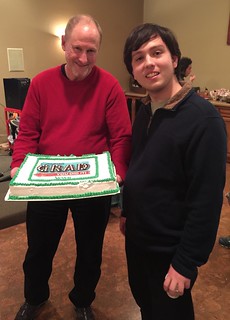

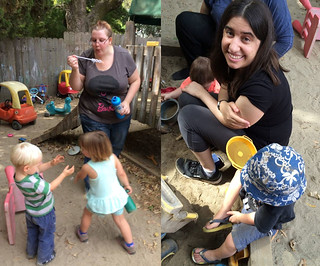

 “Don’t mollycoddle autistic kids”.* How many times have we sat in an audience with other parents, nodding our heads when Temple Grandin gives this advice? After she speaks, we applaud. We get our pictures taken with her, post them on the refrigerator and on our Facebook page. We even get our children to pose with her and hope they will be as successful as she has been. But have we really heard what she is saying, and do we put her advice into practice?
“Don’t mollycoddle autistic kids”.* How many times have we sat in an audience with other parents, nodding our heads when Temple Grandin gives this advice? After she speaks, we applaud. We get our pictures taken with her, post them on the refrigerator and on our Facebook page. We even get our children to pose with her and hope they will be as successful as she has been. But have we really heard what she is saying, and do we put her advice into practice?
